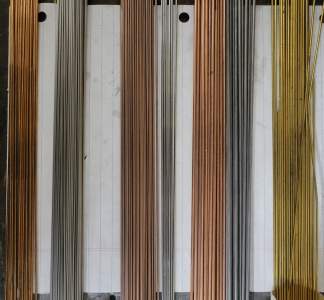I bought an oxy acetylene setup a year or so ago and the gentleman threw in a bunch of brazing rods. Unfortunately they were all mixed up in a few tubes.
I brazed every day at work for over 20 years (retired now) but I never learned how to tell fillers apart by looking at them. Not labeling them is inept.
Silver is expensive, obviously more expensive as the silver content goes up. All the higher-silver filler I've used (40% to 56%) came in a coil packaged in a squat cylinder shaped plastic bin a bit bigger than a hockey puck. We kept it sealed up when not in use, only took off a piece as long as you were going to use that day, because it tarnishes (oxidizes) in air. Given the high cost, it would be a bit idiotic to leave them out loose getting dirty and tarnished. So, assuming the guy wasn't an idiot, I'm guessing those rods aren't silver. Or if they are, they're low silver content.
As I'm sure you know, silver requires flux made for silver. It melts and becomes active at a temperature just a bit lower than where the silver should begin to flow. So that could be a test for whether it's silver or not. If you have to get the steel glowing red for it to flow, then it's not like any silver I've ever used.
Bronze/brass does corrode in air too, but the flux is stronger, more cleaning power to lift oxides, so we aren't as fanatical about cleanliness, but for critical applications it's still worthwhile to scrub it with steel wool or scotchbrite before use, followed by a quick solvent wipe. Obviously not with flux-coated. We mostly went through it fast enough that it was still bright when we used it, but I would clean any old-looking rod before use. Don't make the flux work any harder than it needs to, it has a finite amount of cleaning power so don't use it up.
Nickel-silver (which contains no silver) is silver in color but behaves more like bronze. The liquidus is slightly
higher than bronze, but you can use the same flux as made for bronze brazing. It's really strong, like stronger than a lot of steels, but doesn't flow as well as bronze so not as good for joints that need penetration by capillary action (commonly called "sweating"). One example is brazing cracked cast iron — use regular bronze for that, you need the capillary flow.
Some fillers are made for specialized applications, like metals other than steel. I've only brazed steel and only with a few types of filler, so I can't guess what those other rods are. Maybe try them and see how they work, but not for anything structural unless you're willing to do a lot of destructive testing. That can be as simple as breaking some sample joints with a vise with a cheater bar, no calibration other than your subjective feel for how hard it is to break. After you break enough samples you get a feel for how strong they should be.
Personally I have no use for filler of unknown composition, I'd only use them for non-brazing tasks like bending into hangers for things that will be painted or powdercoated



